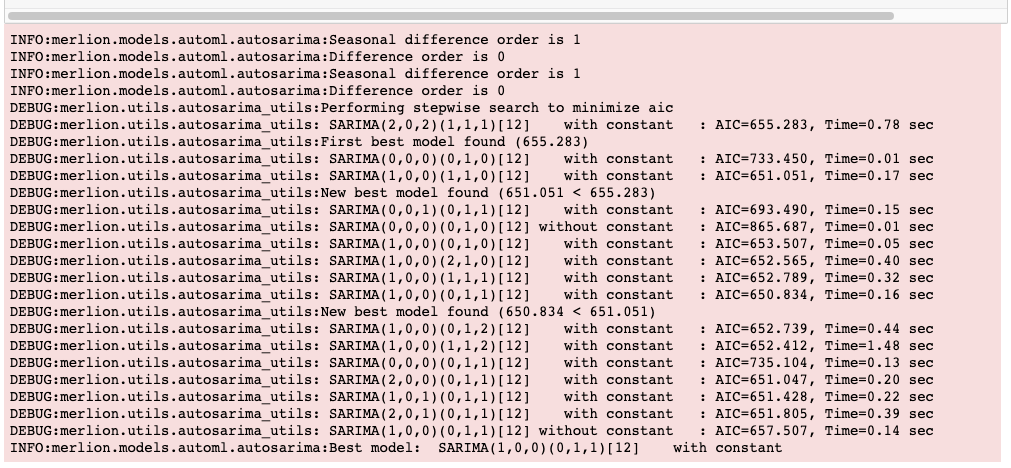New issue
Have a question about this project? Sign up for a free GitHub account to open an issue and contact its maintainers and the community.
By clicking “Sign up for GitHub”, you agree to our terms of service and privacy statement. We’ll occasionally send you account related emails.
Already on GitHub? Sign in to your account
Request to provide a tutorial of some sort to implement AutoML variants of ETS and prophet for univariate forecasting #40
Comments
|
@chenghaoliu89, can you investigate this issue with AutoSARIMA? @riteshchhetri10 re: AutoProphet and AutoETS, you may see the linked API docs. Prophet has a parameter |
|
@riteshchhetri10, would you mind including a code snippet of how you are computing the error as well? |
|
#Here the test_df is just a pandas dataframe containing the univariate air-passengers dataset. (~44 rows ) Merlion AutoSarima did not give good results based on RMSE values for the air-passengers dataset. |
@riteshchhetri10 please remove SeasonalityLayer as follows: If you wrap up the @aadyotb I think we can change the API and expose this confidence level parameters in periodicity detection to the user, what do you think? |
|
@chenghaoliu89 You are right, I removed the |
|
@chenghaoliu89 sounds good. Can you create a PR adding the confidence parameter to the |
@riteshchhetri10 Would you mind sharing the code for comparison with statsmodel and kats? I might help you diagnosis the reason if I can reproduce the RMSE results. |
|
Please see the kaggle notebook containing the entire code which builds the following models and tracks the RMSE for them. You can simply upload the air passengers dataset available on Kaggle and run all cells to get a data frame with the name of the model and RMSE values along with the parameters used. Link to kaggle notebook resulting table What could be the reason that merlion autosarima does not achieve similar scores on the RMSE metric? Also could you please elaborate on how do we obtain the parameters of the best model chosen via merlion.autosarima? |
|
@riteshchhetri10 We can find that the key difference is the detected difference order is different. I check the detailed implementation, both of Merlion and pmdarima use KPSS test to choose the difference order. In Merlion, we directly call it from statsmodel https://www.statsmodels.org/dev/generated/statsmodels.tsa.stattools.kpss.html. The difference is Merlion now uses a trend regression model as default setting for the KPSS test by setting |


Hey, I had been going through the paper "Merlion: A Machine Learning Library for Time Series" and I came across AutoML variants of ETS and prophet models for univariate forecasting. It would be of great help if you could show some tutorial for implementing them, on a simple univariate dataset like the "air-passengers dataset".
I have also tried the AutoSarima for the same dataset from the merlion.models.automl module. But it gives very large errors compared to the auto_arima model from the pmdarima library and even basic statsmodel.tsa SARIMAX methods.
What could be the reason , given that the air-passengers dataset isn't very complicated to forecast?
my code for autosarima.
Link to the paper that I had gone through.
https://arxiv.org/abs/2109.09265
The text was updated successfully, but these errors were encountered: